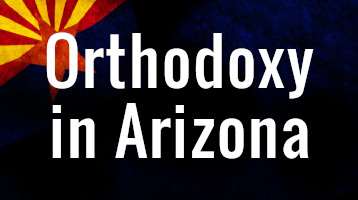Saint Nicholas the Wonderworker
![]()
Archbishop of Myra in Lycia
Our father among the saints Nicholas of Myra, Wonder-worker, was the archbishop of Myra in southern Asia Minor in the fourth century and is also the basis for the Santa Claus legends and imagery which accompany Christmas celebrations in much of the world.
Saint Nicholas, the Wonderworker, Archbishop of Myra in Lycia is famed as a great saint pleasing unto God. He was born in the city of Patara in the region of Lycia (on the south coast of the Asia Minor peninsula), and was the only son of pious parents Theophanes and Nonna, who had vowed to dedicate him to God.
 As the fruit of the prayer of his childless parents, the infant Nicholas from the very day of his birth revealed to people the light of his future glory as a wonderworker. His mother, Nonna, after giving birth was immediately healed from illness. The newborn infant, while still in the baptismal font, stood on his feet three hours, without support from anyone, thereby honoring the Most Holy Trinity. Saint Nicholas from his infancy began a life of fasting, and on Wednesdays and Fridays he would not accept milk from his mother until after his parents had finished their evening prayers.
As the fruit of the prayer of his childless parents, the infant Nicholas from the very day of his birth revealed to people the light of his future glory as a wonderworker. His mother, Nonna, after giving birth was immediately healed from illness. The newborn infant, while still in the baptismal font, stood on his feet three hours, without support from anyone, thereby honoring the Most Holy Trinity. Saint Nicholas from his infancy began a life of fasting, and on Wednesdays and Fridays he would not accept milk from his mother until after his parents had finished their evening prayers.
From his childhood Nicholas thrived on the study of Divine Scripture; by day he would not leave church, and by night he prayed and read books, making himself a worthy dwelling place for the Holy Spirit. Bishop Nicholas of Patara rejoiced at the spiritual success and deep piety of his nephew. He ordained him a reader, and then elevated Nicholas to the priesthood, making him his assistant and entrusting him to instruct the flock.
In serving the Lord the youth was fervent of spirit, and in his proficiency with questions of faith he was like an Elder, who aroused the wonder and deep respect of believers. Constantly at work and vivacious, in unceasing prayer, the priest Nicholas displayed great kind-heartedness towards the flock, and towards the afflicted who came to him for help, and he distributed all his inheritance to the poor.
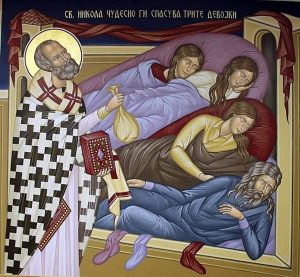 There was a certain formerly rich inhabitant of Patara, whom Saint Nicholas saved from great sin. The man had three grown daughters, and in desperation he planned to sell their bodies so they would have money for food. The saint, learning of the man’s poverty and of his wicked intention, secretly visited him one night and threw a sack of gold through the window. With the money the man arranged an honorable marriage for his daughter. Saint Nicholas also provided gold for the other daughters, thereby saving the family from falling into spiritual destruction. In bestowing charity, Saint Nicholas always strove to do this secretly and to conceal his good deeds.
There was a certain formerly rich inhabitant of Patara, whom Saint Nicholas saved from great sin. The man had three grown daughters, and in desperation he planned to sell their bodies so they would have money for food. The saint, learning of the man’s poverty and of his wicked intention, secretly visited him one night and threw a sack of gold through the window. With the money the man arranged an honorable marriage for his daughter. Saint Nicholas also provided gold for the other daughters, thereby saving the family from falling into spiritual destruction. In bestowing charity, Saint Nicholas always strove to do this secretly and to conceal his good deeds.
 The Bishop of Patara decided to go on pilgrimage to the holy places at Jerusalem, and entrusted the guidance of his flock to Saint Nicholas, who fulfilled this obedience carefully and with love. When the bishop returned, Nicholas asked his blessing for a pilgrimage to the Holy Land. Along the way the saint predicted a storm would arise and threaten the ship. Saint Nicholas saw the devil get on the ship, intending to sink it and kill all the passengers. At the entreaty of the despairing pilgrims, he calmed the waves of the sea by his prayers. Through his prayer a certain sailor of the ship, who had fallen from the mast and was mortally injured, was also restored to health.
The Bishop of Patara decided to go on pilgrimage to the holy places at Jerusalem, and entrusted the guidance of his flock to Saint Nicholas, who fulfilled this obedience carefully and with love. When the bishop returned, Nicholas asked his blessing for a pilgrimage to the Holy Land. Along the way the saint predicted a storm would arise and threaten the ship. Saint Nicholas saw the devil get on the ship, intending to sink it and kill all the passengers. At the entreaty of the despairing pilgrims, he calmed the waves of the sea by his prayers. Through his prayer a certain sailor of the ship, who had fallen from the mast and was mortally injured, was also restored to health.
When he reached the ancient city of Jerusalem and came to Golgotha, Saint Nicholas gave thanks to the Savior. He went to all the holy places, worshiping at each one. One night on Mount Sion, the closed doors of the church opened by themselves for the great pilgrim. Going round the holy places connected with the earthly service of the Son of God, Saint Nicholas decided to withdraw into the desert, but he was stopped by a divine voice urging him to return to his native country. He returned to Lycia, and yearning for a life of quietude, the saint entered into the brotherhood of a monastery named Holy Sion, which had been founded by his uncle. But the Lord again indicated another path for him, “Nicholas, this is not the vineyard where you shall bear fruit for Me. Return to the world, and glorify My Name there.” So he left Patara and went to Myra in Lycia.
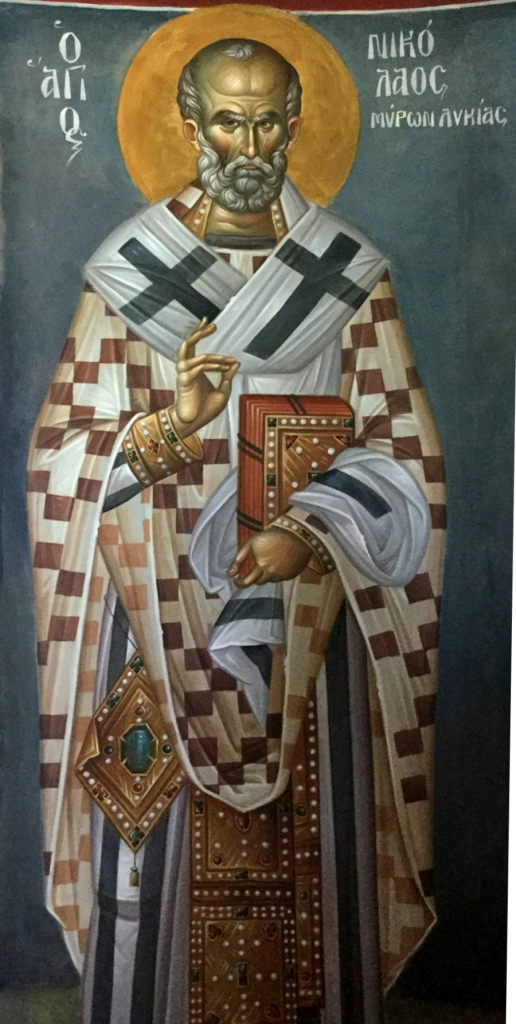 Upon the death of Archbishop John, Nicholas was chosen as Bishop of Myra after one of the bishops of the Council said that a new archbishop should be revealed by God, not chosen by men. One of the elder bishops had a vision of a radiant Man, Who told him that the one who came to the church that night and was first to enter should be made archbishop. He would be named Nicholas. The bishop went to the church at night to await Nicholas. The saint, always the first to arrive at church, was stopped by the bishop. “What is your name, child?” he asked. God’s chosen one replied, “My name is Nicholas, Master, and I am your servant.”
Upon the death of Archbishop John, Nicholas was chosen as Bishop of Myra after one of the bishops of the Council said that a new archbishop should be revealed by God, not chosen by men. One of the elder bishops had a vision of a radiant Man, Who told him that the one who came to the church that night and was first to enter should be made archbishop. He would be named Nicholas. The bishop went to the church at night to await Nicholas. The saint, always the first to arrive at church, was stopped by the bishop. “What is your name, child?” he asked. God’s chosen one replied, “My name is Nicholas, Master, and I am your servant.”
After his consecration as archbishop, Saint Nicholas remained a great ascetic, appearing to his flock as an image of gentleness, kindness and love for people. This was particularly precious for the Lycian Church during the persecution of Christians under the emperor Diocletian (284-305). Bishop Nicholas, locked up in prison together with other Christians for refusing to worship idols, sustained them and exhorted them to endure the fetters, punishment and torture. The Lord preserved him unharmed. Upon the accession of Saint Constantine (May 21) as emperor, Saint Nicholas was restored to his flock, which joyfully received their guide and intercessor.
Despite his great gentleness of spirit and purity of heart, Saint Nicholas was a zealous and ardent warrior of the Church of Christ. Fighting evil spirits, the saint made the rounds of the pagan temples and shrines in the city of Myra and its surroundings, shattering the idols and turning the temples to dust.
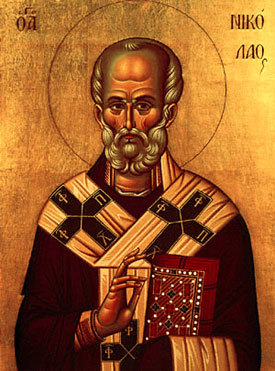 In the year 325 Saint Nicholas was a participant in the First Ecumenical Council. This Council proclaimed the Nicean Symbol of Faith, and he stood up against the heretic Arius with the likes of Saints Sylvester the Bishop of Rome (January 2), Alexander of Alexandria (May 29), Spyridon of Trimythontos (December 12) and other Fathers of the Council.
In the year 325 Saint Nicholas was a participant in the First Ecumenical Council. This Council proclaimed the Nicean Symbol of Faith, and he stood up against the heretic Arius with the likes of Saints Sylvester the Bishop of Rome (January 2), Alexander of Alexandria (May 29), Spyridon of Trimythontos (December 12) and other Fathers of the Council.
Saint Nicholas, fired with zeal for the Lord, assailed the heretic Arius with his words, and also struck him upon the face. For this reason, he was deprived of the emblems of his episcopal rank and placed under guard. But several of the holy Fathers had the same vision, seeing the Lord Himself and the Mother of God returning to him the Gospel and omophorion. The Fathers of the Council agreed that the audacity of the saint was pleasing to God, and restored the saint to the office of bishop.
Having returned to his own diocese, the saint brought it peace and blessings, sowing the word of Truth, uprooting heresy, nourishing his flock with sound doctrine, and also providing food for their bodies.
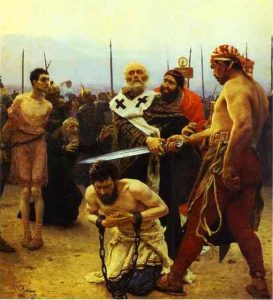 Even during his life the saint worked many miracles. One of the greatest was the deliverance from death of three men unjustly condemned by the Governor, who had been bribed. The saint boldly went up to the executioner and took his sword, already suspended over the heads of the condemned. The Governor, denounced by Saint Nicholas for his wrong doing, repented and begged for forgiveness.
Even during his life the saint worked many miracles. One of the greatest was the deliverance from death of three men unjustly condemned by the Governor, who had been bribed. The saint boldly went up to the executioner and took his sword, already suspended over the heads of the condemned. The Governor, denounced by Saint Nicholas for his wrong doing, repented and begged for forgiveness.
Witnessing this remarkable event were three military officers, who were sent to Phrygia by the emperor Constantine to put down a rebellion. They did not suspect that soon they would also be compelled to seek the intercession of Saint Nicholas. Evil men slandered them before the emperor, and the officers were sentenced to death. Appearing to Saint Constantine in a dream, Saint Nicholas called on him to overturn the unjust sentence of the military officers.
He worked many other miracles, and struggled many long years at his labor. Through the prayers of the saint, the city of Myra was rescued from a terrible famine. He appeared to a certain Italian merchant and left him three gold pieces as a pledge of payment. He requested him to sail to Myra and deliver grain there. More than once, the saint saved those drowning in the sea, and provided release from captivity and imprisonment.
Having reached old age, Saint Nicholas peacefully fell asleep in the Lord. His venerable relics were preserved incorrupt in the local cathedral church and flowed with curative myrrh, from which many received healing. In the year 1087, his relics were transferred to the Italian city of Bari, where they rest even now (See May 9).
The name of the great saint of God, the hierarch and wonderworker Nicholas, a speedy helper and suppliant for all hastening to him, is famed in every corner of the earth, in many lands and among many peoples. In Russia there are a multitude of cathedrals, monasteries and churches consecrated in his name. There is, perhaps, not a single city without a church dedicated to him.
 The first Russian Christian prince Askold (+ 882) was baptized in 866 by Patriarch Photius (February 6) with the name Nicholas. Over the grave of Askold, Saint Olga (July 11) built the first temple of Saint Nicholas in the Russian Church at Kiev. Primary cathedrals were dedicated to Saint Nicholas at Izborsk, Ostrov, Mozhaisk, and Zaraisk. At Novgorod the Great, one of the main churches of the city, the Nikolo-Dvorischensk church, later became a cathedral.
The first Russian Christian prince Askold (+ 882) was baptized in 866 by Patriarch Photius (February 6) with the name Nicholas. Over the grave of Askold, Saint Olga (July 11) built the first temple of Saint Nicholas in the Russian Church at Kiev. Primary cathedrals were dedicated to Saint Nicholas at Izborsk, Ostrov, Mozhaisk, and Zaraisk. At Novgorod the Great, one of the main churches of the city, the Nikolo-Dvorischensk church, later became a cathedral.
Famed and venerable churches and monasteries dedicated to Saint Nicholas are found at Kiev, Smolensk, Pskov, Toropetsa, Galich, Archangelsk, Great Ustiug, Tobolsk. Moscow had dozens of churches named for the saint, and also three monasteries in the Moscow diocese: the Nikolo-Greek (Staryi) in the Chinese-quarter, the Nikolo-Perervinsk and the Nikolo-Ugreshsk. One of the chief towers of the Kremlin was named the Nikolsk.
Many of the churches devoted to the saint were those established at market squares by Russian merchants, sea-farers and those who traveled by land, venerating the wonderworker Nicholas as a protector of all those journeying on dry land and sea. They sometimes received the name among the people of “Nicholas soaked.”
Many village churches in Russia were dedicated to the wonderworker Nicholas, venerated by peasants as a merciful intercessor before the Lord for all the people in their work. And in the Russian land Saint Nicholas did not cease his intercession. Ancient Kiev preserves the memory about the miraculous rescue of a drowning infant by the saint. The great wonderworker, hearing the grief-filled prayers of the parents for the loss of their only child, took the infant from the waters, revived him and placed him in the choir-loft of the church of Holy Wisdom (Hagia Sophia) before his wonderworking icon. In the morning the infant was found safe by his thrilled parents, praising Saint Nicholas the Wonderworker.
Many wonderworking icons of Saint Nicholas appeared in Russia and came also from other lands. There is the ancient Byzantine embordered image of the saint, brought to Moscow from Novgorod, and the large icon painted in the thirteenth century by a Novgorod master.
Two depictions of the wonderworker are especially numerous in the Russian Church: Saint Nicholas of Zaraisk, portrayed in full-length, with his right hand raised in blessing and with a Gospel (this image was brought to Ryazan in 1225 by the future wife of Prince Theodore, the Byzantine Princess Eupraxia, who perished in 1237 with her husband and infant son during the incursion of Batu); and Saint Nicholas of Mozhaisk, also in full stature, with a sword in his right hand and a city in his left. This recalls the miraculous rescue of the city of Mozhaisk from an invasion of enemies, through the prayers of the saint. It is impossible to list all the grace-filled icons of Saint Nicholas, or to enumerate all his miracles.
St. Nicholas as Patron Saint
In addition to children, sailors, and prisoners, many others have laid claim to our father St. Nicholas as patron. The list below shows the great variety of causes which are linked to him. Why did some of these groups become identified with the beloved saint? Some unlikely groups, like thieves and prostitutes, are in his patronage—not because he helps them sin, but because he helps them repent and change. He is also the patron saint of the following nations: Apulia (Italy), Austria, Belgium, Germany, Greece, Italy, Kingdom of Naples (Italy), and a multitude of regions in countries from Albania to Wales.
Archers
Apothecaries (pharmacists)
Armed forces police
Bakers
Bankers
Bargemen
Barrel makers
Boatmen
Boot blacks
Bottlers
Boys
Brewers
Brides
Businessmen
Butchers
Button-makers
Candle makers
Captives
Chandlers (suppliers of ships)
Children
Choristers
Citizens
Clergy
Clerks
Cloth trade & merchants
Coopers (barrelmakers)
Corn merchants
Court recorders, registrars
Dock workers
Drapers
Druggists
Embalmers
Falsely accused
Ferrymen
Firefighters
Fishermen
Florists
Grain dealers & merchants
Grocers
Grooms
Haberdashers
Infants
Infertile
Judges
Lace makers & sellers
Lawsuits lost unjustly
Lawyers
Lemko people, Ukraine
Linen merchants
Longshoremen
Lovers
Maidens
Mariners
Merchants
Military intelligence
Millers
Murderers
Navigators
Newlyweds
Notaries
Oil merchants
Orphans
Packers
Parish clerks
Paupers
Pawnbrokers
Peddlers
Perfumeries
Perfumers
Pharmacists
Pilgrims
Pirates
Poets
Poor people
Preachers
Prisoners
Prostitutes
Pupils
Rag pickers
Ribbon weavers
Robbers & thieves
Schoolchildren
Sailors
Scholars
Sealers
Seed merchants
Shearmen
Shipwreck victims
Shipwrights & gaugers
Ships carpenters
Shoemakers
Shoe shiners
Shopkeepers
Skippers
Soldiers
Spice-dealers
Spinsters
Students
Tanners
Teachers
Thieves
Timber merchants
Travelers
Unjustly condemned
Unmarried men
Unmarried women
Virgins
Watermen
Weavers
Wine porters, merchants & vendors
Women, wishing to marry
Woodturners
He has promised to help those who remember his parents, Theophanes and Nonna.
Saint Nicholas is also commemorated on May 9 (The transfer of his relics) and on July 29 (his nativity).
From St. Nicholas to Sinterklaas to Santa Claus
 In time his fame in northern Europe as a saintly bishop began changing to that of a giver of gifts to children, usually done on December 6. As immigrants from the Germanic and Nordic lands settled in the United States the image of St. Nicholas, or “Sinterklaas,” as he is known among the Dutch, slowly changed to that of “Santa Claus” with little tie to the spiritual life or ethos of Christianity.
In time his fame in northern Europe as a saintly bishop began changing to that of a giver of gifts to children, usually done on December 6. As immigrants from the Germanic and Nordic lands settled in the United States the image of St. Nicholas, or “Sinterklaas,” as he is known among the Dutch, slowly changed to that of “Santa Claus” with little tie to the spiritual life or ethos of Christianity.
Still, his existence as a symbol of generosity and giving continue to inspire billions around the world every year to be a little more generous, a little more merciful, a little more forgiving during the holiday season.

Troparion — Tone 4
The truth of things revealed you to your flock as a rule of faith, /
a model of meekness and a teacher of temperance; /
Therefore you have won the heights by humility, riches by poverty, /
O Holy Father Nicholas,//
entreat Christ our God that our souls may be saved.
Kontakion — Tone 3
You revealed yourself, O saint, in Myra as a priest, /
for you fulfilled the Gospel of Christ /
by giving up your soul for your people, /
and saving the innocent from death. //
Therefore you are blessed as one become wise in the grace of God
